The Cambridge History of China. Vol. 12: Republican China, 1912-1949, Part 1
Подождите немного. Документ загружается.

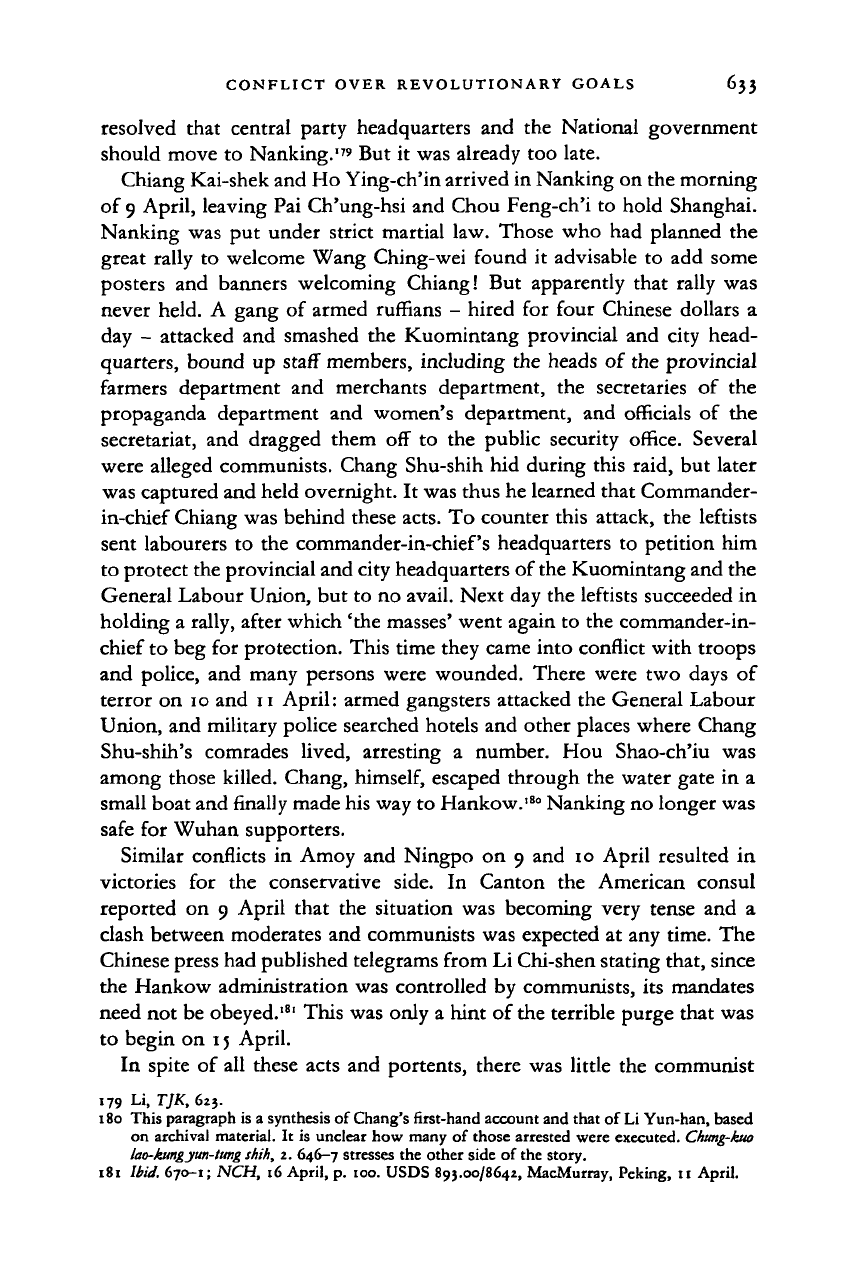
CONFLICT OVER REVOLUTIONARY GOALS 633
resolved that central party headquarters and the National government
should move to Nanking.
179
But it was already too late.
Chiang Kai-shek and Ho Ying-ch'in arrived in Nanking on the morning
of
9
April, leaving Pai Ch'ung-hsi and Chou Feng-ch'i to hold Shanghai.
Nanking was put under strict martial law. Those who had planned the
great rally to welcome Wang Ching-wei found it advisable to add some
posters and banners welcoming Chiang! But apparently that rally was
never held. A gang of armed ruffians - hired for four Chinese dollars a
day - attacked and smashed the Kuomintang provincial and city head-
quarters, bound up staff members, including the heads of the provincial
farmers department and merchants department, the secretaries of the
propaganda department and women's department, and officials of the
secretariat, and dragged them off to the public security office. Several
were alleged communists. Chang Shu-shih hid during this raid, but later
was captured and held overnight. It was thus he learned that Commander-
in-chief Chiang was behind these acts. To counter this attack, the leftists
sent labourers to the commander-in-chief's headquarters to petition him
to protect the provincial and city headquarters of the Kuomintang and the
General Labour Union, but to no avail. Next day the leftists succeeded in
holding a rally, after which 'the masses' went again to the commander-in-
chief to beg for protection. This time they came into conflict with troops
and police, and many persons were wounded. There were two days of
terror on 10 and n April: armed gangsters attacked the General Labour
Union, and military police searched hotels and other places where Chang
Shu-shih's comrades lived, arresting a number. Hou Shao-ch'iu was
among those killed. Chang,
himself,
escaped through the water gate in a
small boat and finally made his way to Hankow.
180
Nanking no longer was
safe for Wuhan supporters.
Similar conflicts in Amoy and Ningpo on 9 and 10 April resulted in
victories for the conservative side. In Canton the American consul
reported on 9 April that the situation was becoming very tense and a
clash between moderates and communists was expected at any time. The
Chinese press had published telegrams from Li Chi-shen stating that, since
the Hankow administration was controlled by communists, its mandates
need not be obeyed.
l!l
This was only a hint of the terrible purge that was
to begin on 15 April.
In spite of all these acts and portents, there was little the communist
179 Li, TJK, 623.
180 This paragraph is a synthesis of Chang's first-hand account and that of Li Yun-han, based
on archival material. It is unclear how many of those arrested were executed.
Chtmg-kuo
lao-kungym-tung
shih,
2. 646-7 stresses the other side of the story.
181
Ibid.
670-1;
NCH, 16 April, p. 100. USDS 893.00/8642, MacMurray, Peking, 11 April.
Cambridge Histories Online © Cambridge University Press, 2008
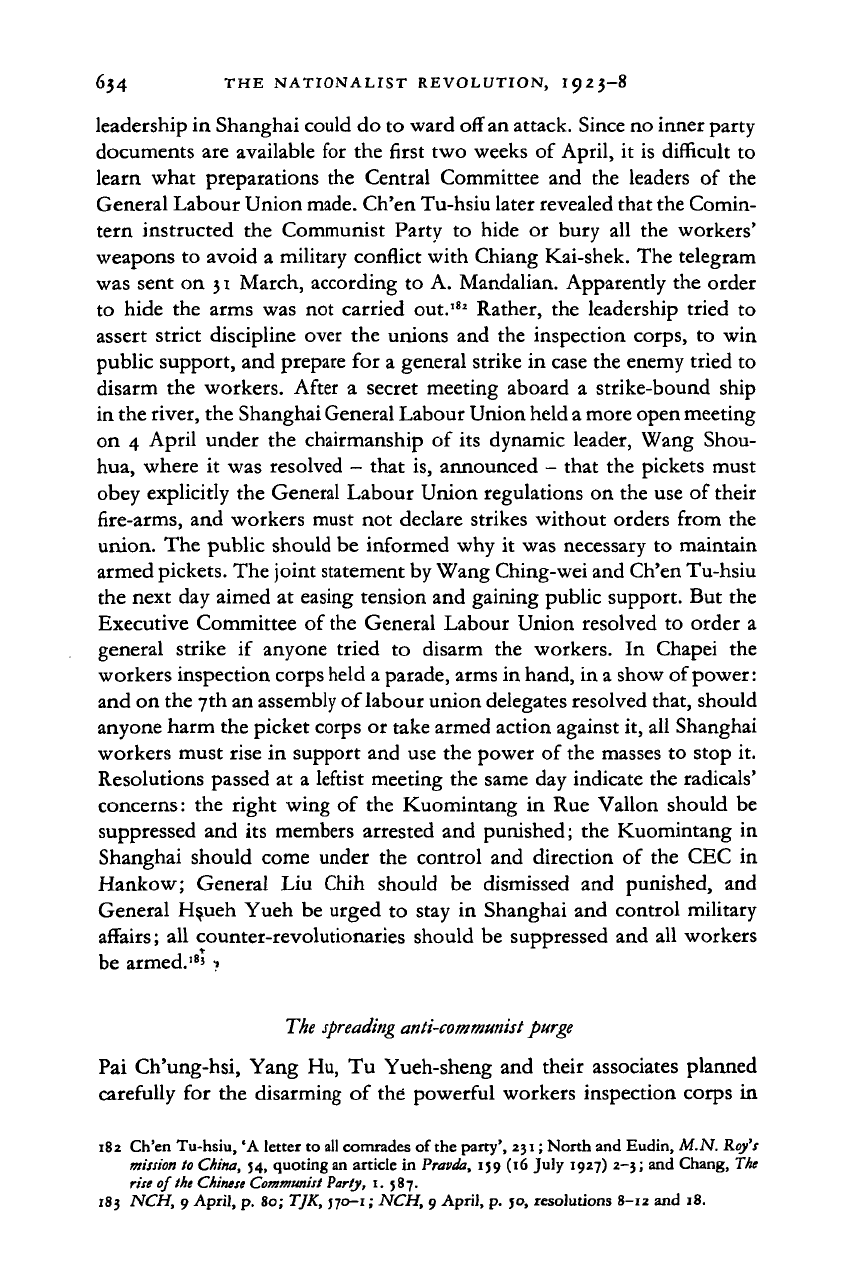
634
THE
NATIONALIST REVOLUTION, 1923-8
leadership in Shanghai could do to ward off an attack. Since no inner party
documents are available for the first two weeks
of
April,
it
is difficult
to
learn what preparations the Central Committee
and the
leaders
of
the
General Labour Union
made.
Ch'en Tu-hsiu later revealed that the Comin-
tern instructed
the
Communist Party
to
hide
or
bury
all the
workers'
weapons to avoid
a
military conflict with Chiang Kai-shek. The telegram
was sent on 31 March, according to A. Mandalian. Apparently the order
to hide
the
arms was not carried out.'
82
Rather,
the
leadership tried
to
assert strict discipline over the unions and the inspection corps,
to
win
public support, and prepare for a general strike in case the enemy tried to
disarm the workers. After
a
secret meeting aboard
a
strike-bound ship
in the river, the Shanghai General Labour Union held a more open meeting
on
4
April under
the
chairmanship
of
its dynamic leader, Wang Shou-
hua, where
it
was resolved
-
that is, announced
-
that the pickets must
obey explicitly the General Labour Union regulations on the use of their
fire-arms, and workers must not declare strikes without orders from the
union. The public should be informed why
it
was necessary
to
maintain
armed pickets. The joint statement by Wang Ching-wei and Ch'en Tu-hsiu
the next day aimed
at
easing tension and gaining public support. But the
Executive Committee of the General Labour Union resolved
to
order
a
general strike
if
anyone tried
to
disarm
the
workers.
In
Chapei
the
workers inspection corps held a parade, arms in hand, in a show of power:
and on the 7th an assembly of labour union delegates resolved that, should
anyone harm the picket corps or take armed action against it, all Shanghai
workers must rise in support and use the power
of
the masses
to
stop
it.
Resolutions passed
at a
leftist meeting the same day indicate the radicals'
concerns:
the
right wing
of
the Kuomintang
in
Rue Vallon should
be
suppressed and
its
members arrested and punished; the Kuomintang
in
Shanghai should come under
the
control and direction
of
the CEC
in
Hankow; General
Liu
Chih should
be
dismissed
and
punished,
and
General Hsueh Yueh be urged
to
stay
in
Shanghai and control military
affairs; all counter-revolutionaries should be suppressed and all workers
be armed.
lB
' ?
The
spreading
anti-communist
purge
Pai Ch'ung-hsi, Yang Hu,
Tu
Yueh-sheng and their associates planned
carefully
for
the disarming
of
the powerful workers inspection corps
in
182 Ch'en Tu-hsiu, 'A letter to all comrades of the party', 231; North and Eudin,
M.N.
Roy's
mission
to China, 54, quoting an article in Pravda, 159 (16 July 1927) 2-3; and Chang, The
rise of
the Chinese Communist
Party,
1.
587.
183
NCH, 9
April, p. 80; TJK,
w>-i1 NCH, 9
April, p. 50, resolutions 8-12 and 18.
Cambridge Histories Online © Cambridge University Press, 2008
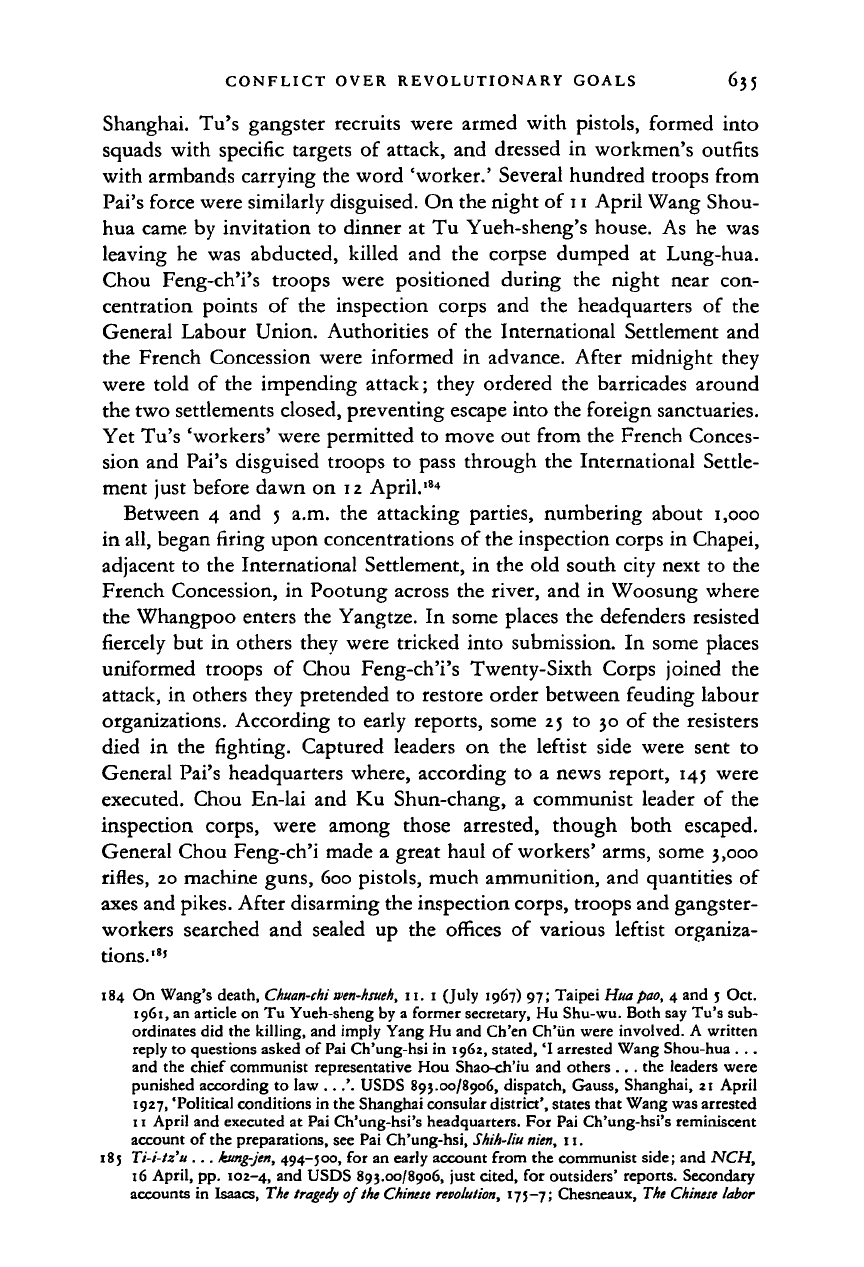
CONFLICT OVER REVOLUTIONARY GOALS 635
Shanghai. Tu's gangster recruits were armed with pistols, formed into
squads with specific targets of attack, and dressed in workmen's outfits
with armbands carrying the word 'worker.' Several hundred troops from
Pai's force were similarly disguised. On the night of
11
April Wang Shou-
hua came by invitation to dinner at Tu Yueh-sheng's house. As he was
leaving he was abducted, killed and the corpse dumped at Lung-hua.
Chou Feng-ch'i's troops were positioned during the night near con-
centration points of the inspection corps and the headquarters of the
General Labour Union. Authorities of the International Settlement and
the French Concession were informed in advance. After midnight they
were told of the impending attack; they ordered the barricades around
the two settlements closed, preventing escape into the foreign sanctuaries.
Yet Tu's 'workers' were permitted to move out from the French Conces-
sion and Pai's disguised troops to pass through the International Settle-
ment just before dawn on 12 April.
184
Between 4 and 5 a.m. the attacking parties, numbering about 1,000
in all, began firing upon concentrations of the inspection corps in Chapei,
adjacent to the International Settlement, in the old south city next to the
French Concession, in Pootung across the river, and in Woosung where
the Whangpoo enters the Yangtze. In some places the defenders resisted
fiercely but in others they were tricked into submission. In some places
uniformed troops of Chou Feng-ch'i's Twenty-Sixth Corps joined the
attack, in others they pretended to restore order between feuding labour
organizations. According to early reports, some 25 to 30 of the resisters
died in the fighting. Captured leaders on the leftist side were sent to
General Pai's headquarters where, according to a news report, 145 were
executed. Chou En-lai and Ku Shun-chang, a communist leader of the
inspection corps, were among those arrested, though both escaped.
General Chou Feng-ch'i made a great haul of workers' arms, some 3,000
rifles,
20 machine guns, 600 pistols, much ammunition, and quantities of
axes and pikes. After disarming the inspection corps, troops and gangster-
workers searched and sealed up the offices of various leftist organiza-
tions.
18
'
184 On Wang's death, Chuan-M
wen-hsueh,
11. 1 (July 1967) 97; Taipei Huapao, 4 and 5 Oct.
1961,
an article on Tu Yueh-sheng by a former secretary, Hu Shu-wu. Both say Tu's sub-
ordinates did the killing, and imply Yang Hu and Ch'en Ch'iin were involved. A written
reply to questions asked of Pai Ch'ung-hsi in 1962, stated, 'I arrested Wang Shou-hua . ..
and the chief communist representative Hou Shao-ch'iu and others . . . the leaders were
punished according to law ...'. USDS 893.00/8906, dispatch, Gauss, Shanghai, zi April
1927, 'Political conditions in the Shanghai consular district', states that Wang was arrested
11 April and executed at Pai Ch'ung-hsi's headquarters. For Pai Ch'ung-hsi's reminiscent
account of the preparations, see Pai Ch'ung-hsi,
Shih-liu
nien,
11.
185 Ti-i-tz'u . . . hmg-jen, 494-500, for an early account from the communist side; and NCH,
16 April, pp. 102-4,
ar
>d USDS 893.00/8906, just cited, for outsiders' reports. Secondary
accounts in Isaacs, The
tragedy
of
the Chinese
revolution,
175-7; Chesneaux,
The Chinese
labor
Cambridge Histories Online © Cambridge University Press, 2008
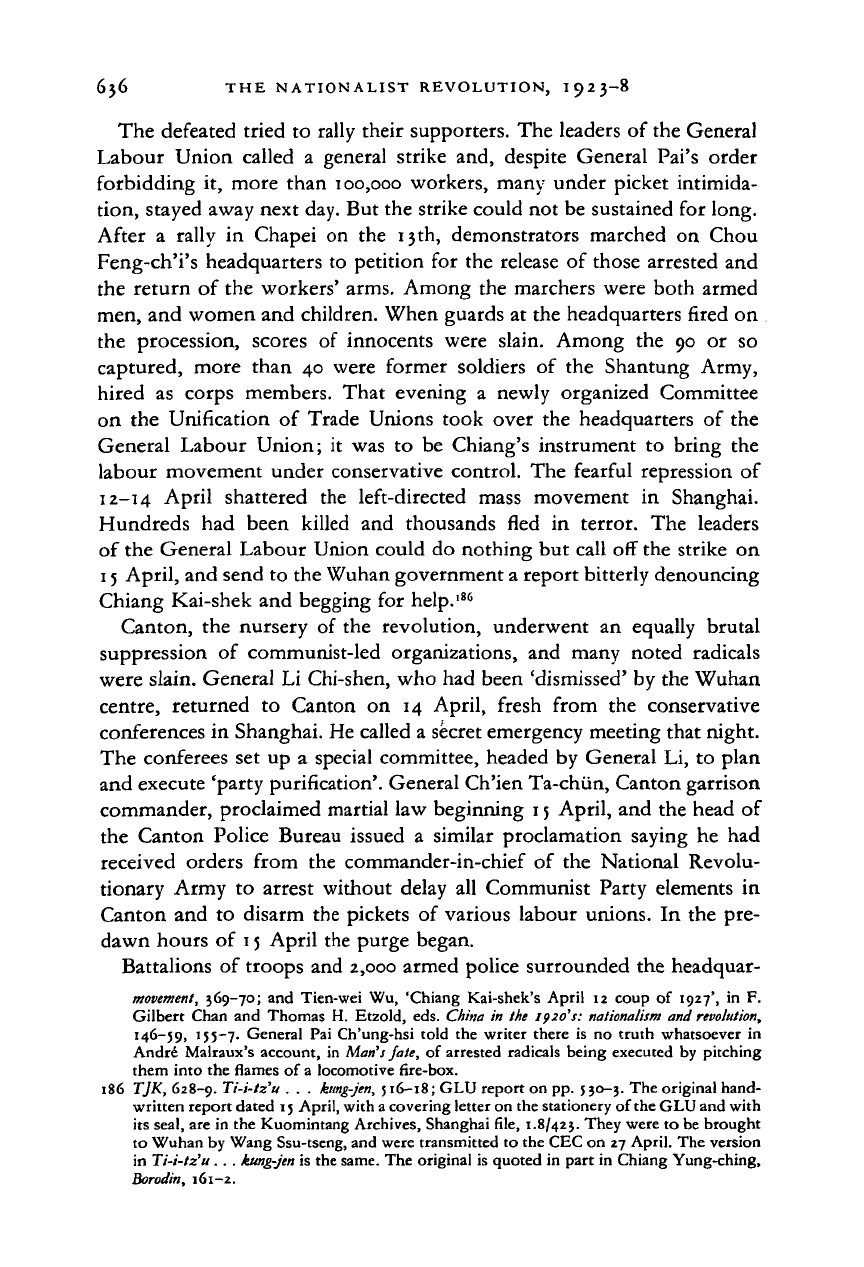
636 THE NATIONALIST REVOLUTION, 1923-8
The defeated tried
to
rally their supporters. The leaders
of
the General
Labour Union called
a
general strike
and,
despite General Pai's order
forbidding
it,
more than 100,000 workers, many under picket intimida-
tion, stayed away next day. But the strike could not be sustained
for
long.
After
a
rally
in
Chapei
on the 13th,
demonstrators marched
on
Chou
Feng-ch'i's headquarters
to
petition
for the
release
of
those arrested
and
the return
of
the workers' arms. Among
the
marchers were both armed
men, and women and children. When guards
at
the headquarters fired
on
the procession, scores
of
innocents were slain. Among
the 90 or so
captured, more than
40
were former soldiers
of the
Shantung Army,
hired
as
corps members. That evening
a
newly organized Committee
on
the
Unification
of
Trade Unions took over
the
headquarters
of the
General Labour Union;
it was to be
Chiang's instrument
to
bring
the
labour movement under conservative control.
The
fearful repression
of
12-14 April shattered
the
left-directed mass movement
in
Shanghai.
Hundreds
had
been killed
and
thousands fled
in
terror.
The
leaders
of the General Labour Union could
do
nothing
but
call
off
the strike
on
15 April, and send
to
the Wuhan government a report bitterly denouncing
Chiang Kai-shek
and
begging
for
help.'
86
Canton,
the
nursery
of the
revolution, underwent
an
equally brutal
suppression
of
communist-led organizations,
and
many noted radicals
were slain. General
Li
Chi-shen, who had been 'dismissed' by the Wuhan
centre, returned
to
Canton
on 14
April, fresh from
the
conservative
conferences
in
Shanghai. He called
a
secret emergency meeting that night.
The conferees
set up a
special committee, headed
by
General Li,
to
plan
and execute 'party purification'. General Ch'ien Ta-chiin, Canton garrison
commander, proclaimed martial law beginning 15 April,
and
the head
of
the Canton Police Bureau issued
a
similar proclamation saying
he had
received orders from
the
commander-in-chief
of the
National Revolu-
tionary Army
to
arrest without delay
all
Communist Party elements
in
Canton
and to
disarm
the
pickets
of
various labour unions.
In the
pre-
dawn hours
of
15 April the purge began.
Battalions
of
troops
and
2,000 armed police surrounded the headquar-
movement, 369-70;
and
Tien-wei
Wu,
'Chiang Kai-shek's April
12
coup
of
1927',
in F.
Gilbert Chan
and
Thomas
H.
Etzold,
eds.
China
in the
1920's: nationalism and
revolution,
146-59,
155-7. General
Pai
Ch'ung-hsi told
the
writer there
is no
truth whatsoever
in
Andr£ Malraux's account,
in
Man'j
fate,
of
arrested radicals being executed
by
pitching
them into the flames
of
a
locomotive fire-box.
186 TJK, 628-9. Ti-i-tz'u
. . .
kung-jen,
516-18; GLU report on pp.
530-3.
The original hand-
written report dated
15
April, with a covering letter on the stationery of the GLU and with
its seal, are
in
the Kuomintang Archives, Shanghai file, 1.8/423. They were
to
be brought
to Wuhan by Wang Ssu-tseng, and were transmitted to the CEC on 27 April. The version
in Ti-i-tz'u .
. .
kung-jen
is the same. The original is quoted
in
part
in
Chiang Yung-ching,
Borodin, 161-2.
Cambridge Histories Online © Cambridge University Press, 2008
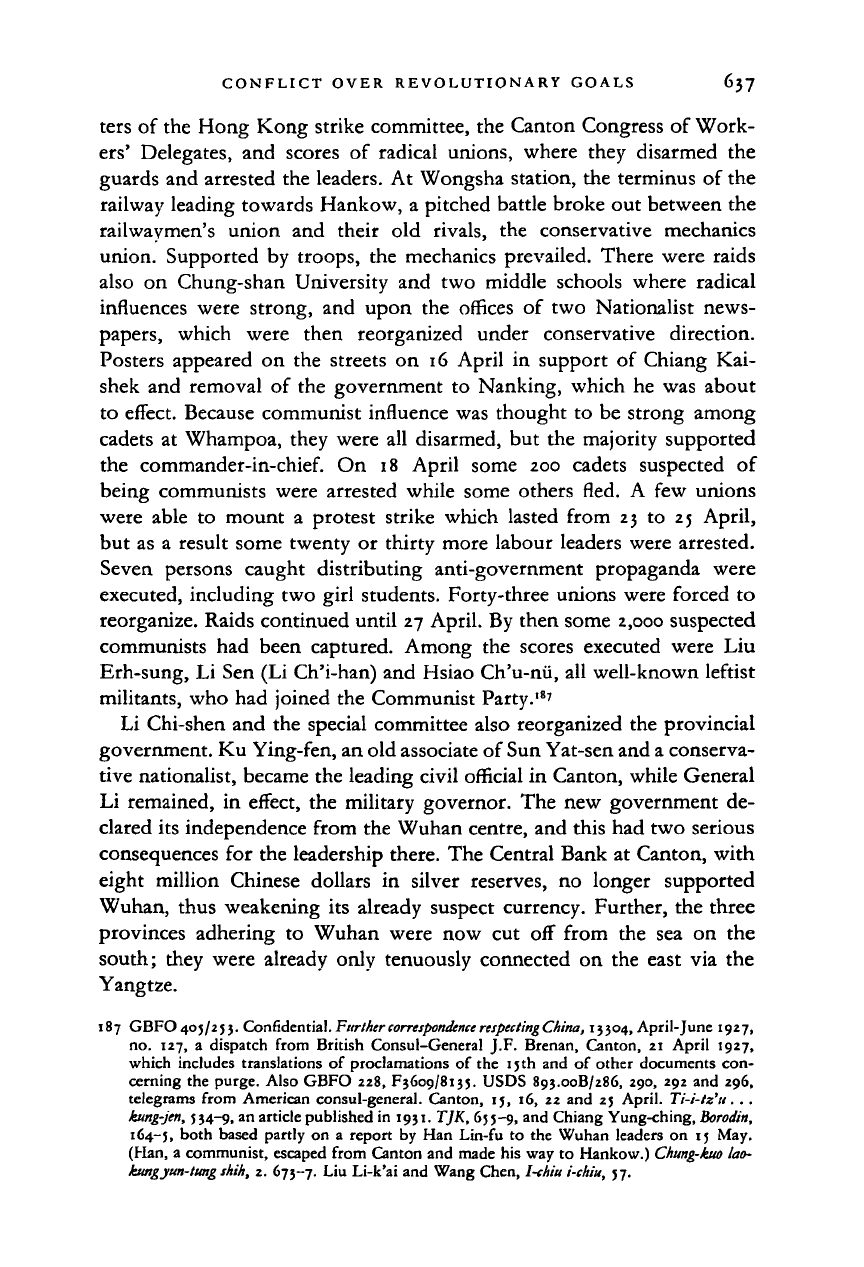
CONFLICT OVER REVOLUTIONARY GOALS 637
ters of the Hong Kong strike committee, the Canton Congress of Work-
ers'
Delegates, and scores of radical unions, where they disarmed the
guards and arrested the leaders. At Wongsha station, the terminus of the
railway leading towards Hankow, a pitched battle broke out between the
railwaymen's union and their old rivals, the conservative mechanics
union. Supported by troops, the mechanics prevailed. There were raids
also on Chung-shan University and two middle schools where radical
influences were strong, and upon the offices of two Nationalist news-
papers, which were then reorganized under conservative direction.
Posters appeared on the streets on 16 April in support of Chiang Kai-
shek and removal of the government to Nanking, which he was about
to effect. Because communist influence was thought to be strong among
cadets at Whampoa, they were all disarmed, but the majority supported
the commander-in-chief. On 18 April some 200 cadets suspected of
being communists were arrested while some others fled. A few unions
were able to mount a protest strike which lasted from 23 to 25 April,
but as a result some twenty or thirty more labour leaders were arrested.
Seven persons caught distributing anti-government propaganda were
executed, including two girl students. Forty-three unions were forced to
reorganize. Raids continued until 27 April. By then some 2,000 suspected
communists had been captured. Among the scores executed were Liu
Erh-sung, Li Sen (Li Ch'i-han) and Hsiao Ch'u-nii, all well-known leftist
militants, who had joined the Communist Party.'
8
'
Li Chi-shen and the special committee also reorganized the provincial
government. Ku Ying-fen, an old associate of Sun Yat-sen and a conserva-
tive nationalist, became the leading civil official in Canton, while General
Li remained, in effect, the military governor. The new government de-
clared its independence from the Wuhan centre, and this had two serious
consequences for the leadership there. The Central Bank at Canton, with
eight million Chinese dollars in silver reserves, no longer supported
Wuhan, thus weakening its already suspect currency. Further, the three
provinces adhering to Wuhan were now cut off from the sea on the
south; they were already only tenuously connected on the east via the
Yangtze.
187 GBFO 405/253. Confidential.FurthercorrespondencerespcctingChina, 13304, April-June 1927,
no.
127, a dispatch from British Consul-General J.F. Brenan, Canton, 21 April 1927,
which includes translations of proclamations of the 15th and of other documents con-
cerning the purge. Also GBFO 228, F3609/8135. USDS 893.00B/286, 290, 292 and 296,
telegrams from American consul-general. Canton, 15, 16, 22 and 25 April. Ti-i-tz'u. . .
kung-jen,
534-9, an article published in 1931. TJK, 655-9,
a
"d Chiang Yung-ching,
Borodin,
164-5,
both based partly on a report by Han Lin-fu to the Wuhan leaders on 15 May.
(Han, a communist, escaped from Canton and made his way to Hankow.)
Chung-kuo
lao-
kungyun-tung
shih,
2. 673-7. Liu Li-k'ai and Wang Chen,
I-c/iiu
i-chiu,
57.
Cambridge Histories Online © Cambridge University Press, 2008
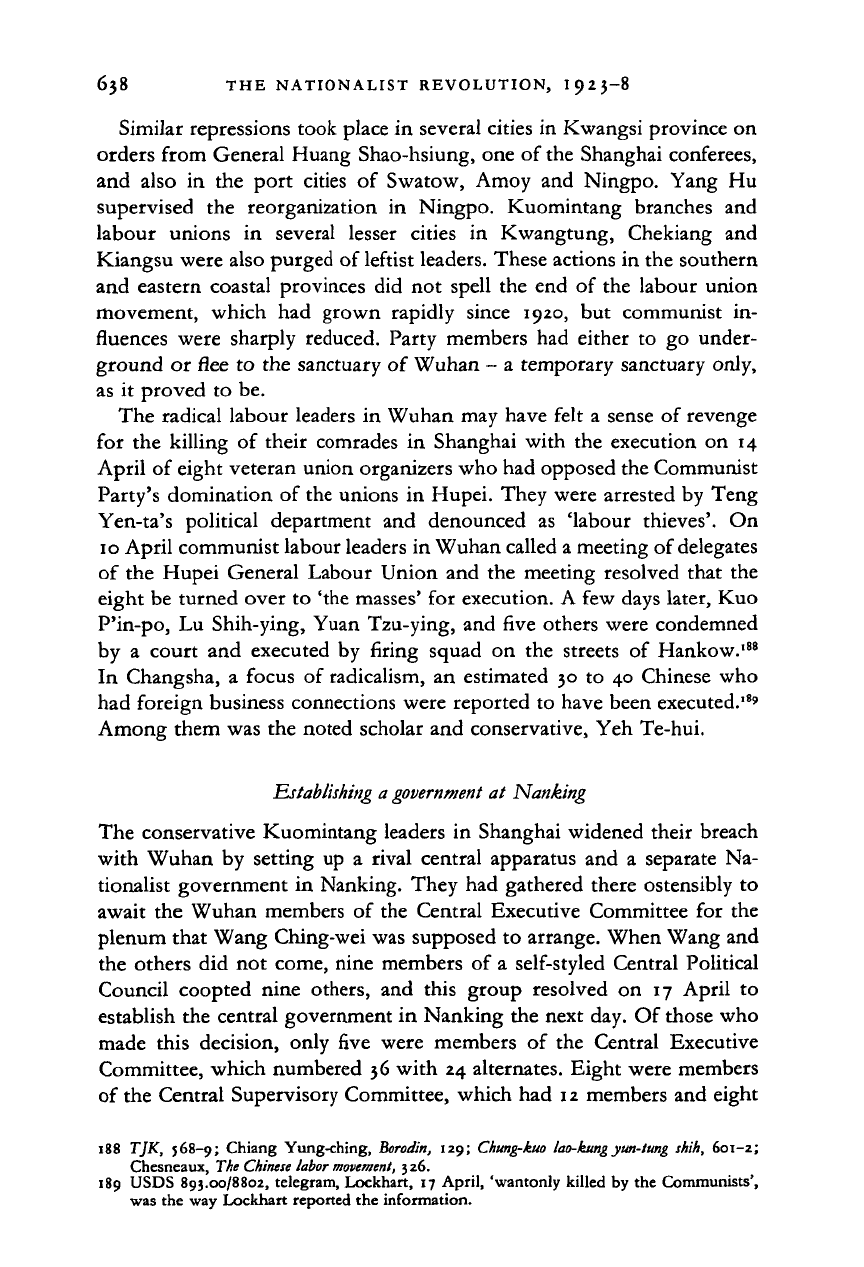
638 THE NATIONALIST REVOLUTION, I923-8
Similar repressions took place in several cities in Kwangsi province on
orders from General Huang Shao-hsiung, one of the Shanghai conferees,
and also
in the
port cities
of
Swatow, Amoy
and
Ningpo. Yang
Hu
supervised
the
reorgani2ation
in
Ningpo. Kuomintang branches
and
labour unions
in
several lesser cities
in
Kwangtung, Chekiang
and
Kiangsu were also purged of leftist leaders. These actions in the southern
and eastern coastal provinces did
not
spell the end
of
the labour union
movement, which
had
grown rapidly since 1920,
but
communist
in-
fluences were sharply reduced. Party members had either
to go
under-
ground
or
flee
to
the sanctuary
of
Wuhan
- a
temporary sanctuary only,
as
it
proved
to
be.
The radical labour leaders
in
Wuhan may have felt
a
sense
of
revenge
for
the
killing
of
their comrades
in
Shanghai with the execution
on 14
April
of
eight veteran union organizers who had opposed the Communist
Party's domination
of
the unions
in
Hupei. They were arrested by Teng
Yen-ta's political department
and
denounced
as
'labour thieves'.
On
10 April communist labour leaders in Wuhan called a meeting of delegates
of the Hupei General Labour Union and the meeting resolved that
the
eight be turned over to 'the masses' for execution. A few days later, Kuo
P'in-po,
Lu
Shih-ying, Yuan Tzu-ying, and five others were condemned
by
a
court
and
executed
by
firing squad
on the
streets
of
Hankow.
188
In Changsha,
a
focus
of
radicalism,
an
estimated 30
to 40
Chinese who
had foreign business connections were reported
to
have been executed.
189
Among them was the noted scholar and conservative, Yeh Te-hui.
Establishing a
government
at
Nanking
The conservative Kuomintang leaders
in
Shanghai widened their breach
with Wuhan
by
setting
up a
rival central apparatus and
a
separate Na-
tionalist government
in
Nanking. They had gathered there ostensibly
to
await the Wuhan members
of
the Central Executive Committee
for the
plenum that Wang Ching-wei was supposed to arrange. When Wang and
the others did not come, nine members
of a
self-styled Central Political
Council coopted nine others,
and
this group resolved
on 17
April
to
establish the central government in Nanking the next day. Of those who
made this decision, only five were members
of
the Central Executive
Committee, which numbered 36 with 24 alternates. Eight were members
of the Central Supervisory Committee, which had 12 members and eight
188 TJK, 568-9; Chiang Yung-ching,
Borodin,
J29;
Chung-kuo lao-kung yun-tung
shih, 601-2;
Chesneaux,
The Chinese
labor
movement,
3
26.
189 USDS 893.00/8802, telegram, Lockhart, 17 April, 'wantonly killed by the Communists',
was the way Lockhart reported the information.
Cambridge Histories Online © Cambridge University Press, 2008
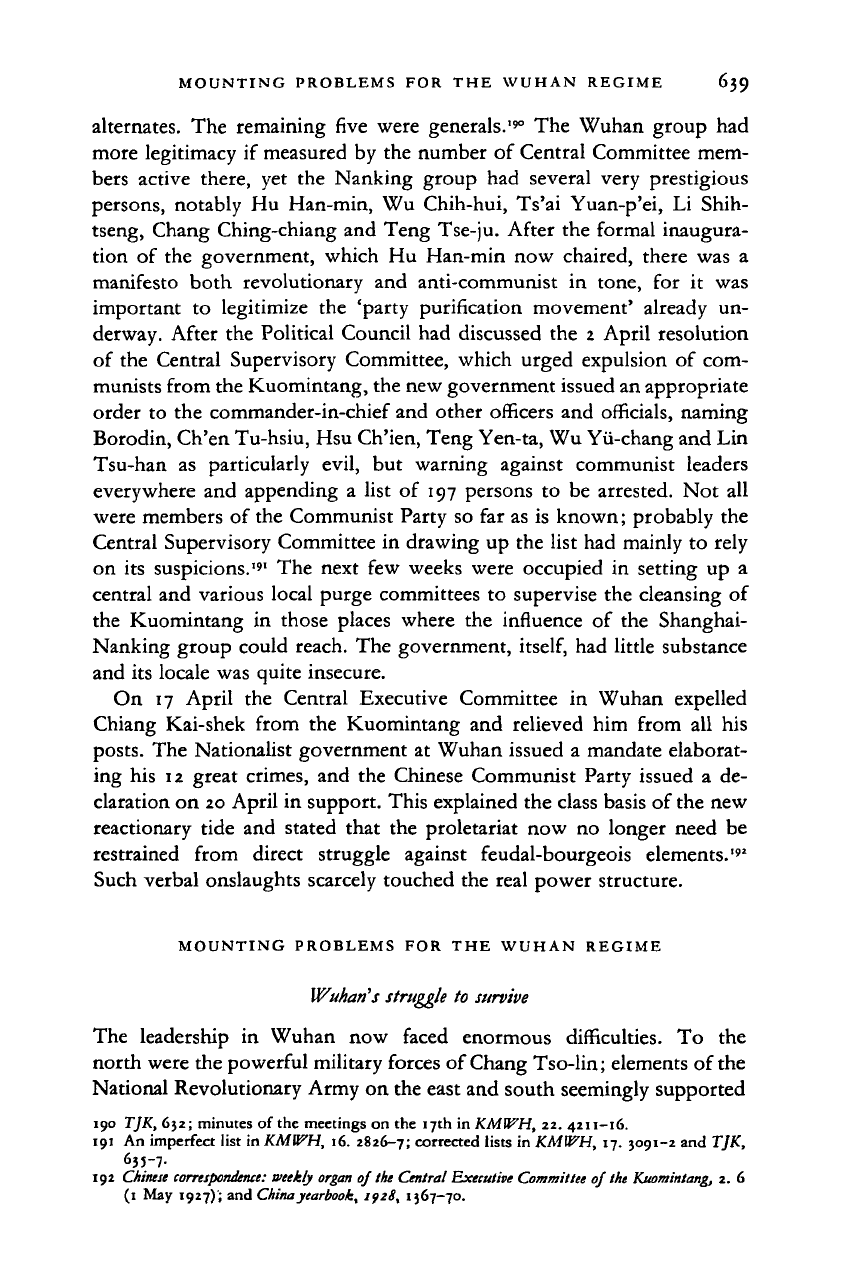
MOUNTING PROBLEMS FOR THE WUHAN REGIME 639
alternates.
The
remaining five were generals.'
9
"
The
Wuhan group
had
more legitimacy
if
measured
by the
number
of
Central Committee mem-
bers active there,
yet the
Nanking group
had
several very prestigious
persons, notably
Hu
Han-min,
Wu
Chih-hui, Ts'ai Yuan-p'ei,
Li
Shih-
tseng, Chang Ching-chiang
and
Teng Tse-ju. After
the
formal inaugura-
tion
of the
government, which
Hu
Han-min
now
chaired, there
was a
manifesto both revolutionary
and
anti-communist
in
tone,
for it was
important
to
legitimize
the
'party purification movement' already
un-
derway. After
the
Political Council
had
discussed
the 2
April resolution
of
the
Central Supervisory Committee, which urged expulsion
of
com-
munists from the Kuomintang, the new government issued an appropriate
order
to the
commander-in-chief and other officers
and
officials, naming
Borodin, Ch'en Tu-hsiu, Hsu Ch'ien, Teng Yen-ta, Wu Yii-chang and Lin
Tsu-han
as
particularly evil,
but
warning against communist leaders
everywhere
and
appending
a
list
of
197 persons
to be
arrested.
Not all
were members
of
the Communist Party
so far
as
is
known; probably
the
Central Supervisory Committee
in
drawing
up the
list
had
mainly
to
rely
on
its
suspicions.'
9
'
The
next
few
weeks were occupied
in
setting
up a
central
and
various local purge committees
to
supervise
the
cleansing
of
the Kuomintang
in
those places where
the
influence
of the
Shanghai-
Nanking group could reach.
The
government,
itself,
had
little substance
and
its
locale was quite insecure.
On
17
April
the
Central Executive Committee
in
Wuhan expelled
Chiang Kai-shek from
the
Kuomintang
and
relieved
him
from
all his
posts.
The
Nationalist government
at
Wuhan issued
a
mandate elaborat-
ing
his 12
great crimes,
and the
Chinese Communist Party issued
a de-
claration
on
20 April
in
support. This explained the class basis
of
the new
reactionary tide
and
stated that
the
proletariat
now no
longer need
be
restrained from direct struggle against feudal-bourgeois elements.
'»*
Such verbal onslaughts scarcely touched
the
real power structure.
MOUNTING PROBLEMS FOR THE WUHAN REGIME
Wuhan's
struggle
to
survive
The leadership
in
Wuhan
now
faced enormous difficulties.
To the
north were the powerful military forces
of
Chang Tso-lin; elements
of
the
National Revolutionary Army
on
the east and south seemingly supported
190 TJK, 632; minutes
of
the meetings
on the
17th
in
KMWH,
22.
4211-16.
191
An
imperfect list
in
KMWH,
16.
2826-7; corrected lists
in
KMWH,
17.
3091-2 and
TJK,
655-7-
192
Chinese
correspondence:
weekly organ
oj
the
Central Executive Committee
of
the
Kuomintang,
2. 6
(1
May
1927); and China yearbook, 1928, 1367-70.
Cambridge Histories Online © Cambridge University Press, 2008
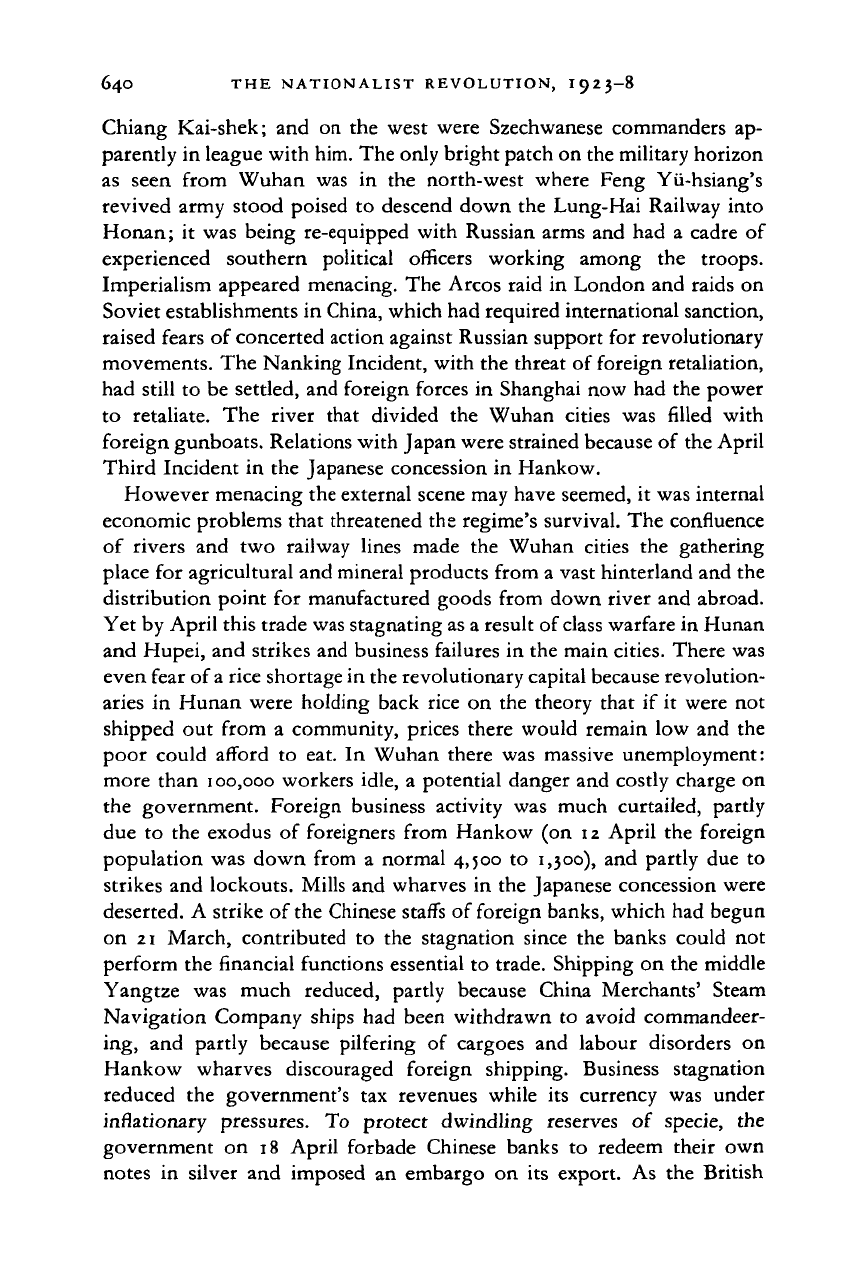
640 THE NATIONALIST REVOLUTION, I923-8
Chiang Kai-shek;
and on
the west were Szechwanese commanders ap-
parently in league with him. The only bright patch on the military horizon
as seen from Wuhan was
in the
north-west where Feng Yii-hsiang's
revived army stood poised
to
descend down the Lung-Hai Railway into
Honan;
it
was being re-equipped with Russian arms and had
a
cadre
of
experienced southern political officers working among
the
troops.
Imperialism appeared menacing. The Arcos raid in London and raids on
Soviet establishments in China, which had required international sanction,
raised fears of concerted action against Russian support for revolutionary
movements. The Nanking Incident, with the threat of foreign retaliation,
had still to be settled, and foreign forces in Shanghai now had the power
to retaliate.
The
river that divided
the
Wuhan cities
was
filled with
foreign gunboats. Relations with Japan were strained because
of
the April
Third Incident
in
the Japanese concession in Hankow.
However menacing the external scene may have seemed,
it
was internal
economic problems that threatened the regime's survival. The confluence
of rivers
and two
railway lines made
the
Wuhan cities
the
gathering
place for agricultural and mineral products from a vast hinterland and the
distribution point
for
manufactured goods from down river and abroad.
Yet by April this trade was stagnating as a result of
class
warfare in Hunan
and Hupei, and strikes and business failures in the main cities. There was
even fear of
a
rice shortage in the revolutionary capital because revolution-
aries
in
Hunan were holding back rice
on
the theory that
if it
were not
shipped out from
a
community, prices there would remain low and
the
poor could afford
to
eat.
In
Wuhan there was massive unemployment:
more than 100,000 workers idle,
a
potential danger and costly charge on
the government. Foreign business activity
was
much curtailed, partly
due
to
the exodus
of
foreigners from Hankow (on 12 April the foreign
population was down from
a
normal 4,500
to
1,300),
and partly due
to
strikes and lockouts. Mills and wharves
in
the Japanese concession were
deserted. A strike of the Chinese staffs of foreign banks, which had begun
on 21 March, contributed
to the
stagnation since
the
banks could
not
perform the financial functions essential to trade. Shipping on the middle
Yangtze
was
much reduced, partly because China Merchants' Steam
Navigation Company ships had been withdrawn
to
avoid commandeer-
ing,
and
partly because pilfering
of
cargoes
and
labour disorders
on
Hankow wharves discouraged foreign shipping. Business stagnation
reduced
the
government's
tax
revenues while
its
currency
was
under
inflationary pressures.
To
protect dwindling reserves
of
specie,
the
government
on 18
April forbade Chinese banks
to
redeem their own
notes
in
silver
and
imposed
an
embargo
on its
export.
As the
British
Cambridge Histories Online © Cambridge University Press, 2008
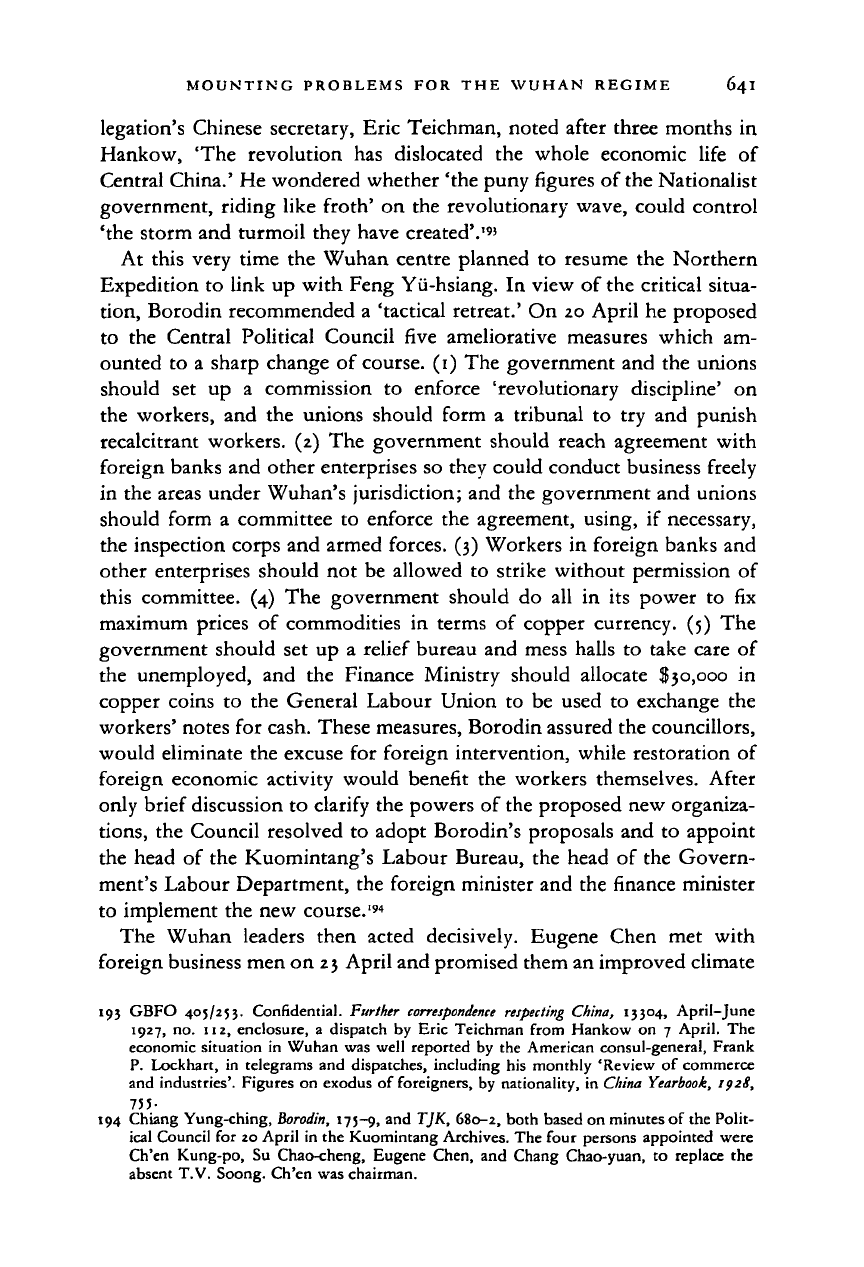
MOUNTING PROBLEMS
FOR THE
WUHAN REGIME
641
legation's Chinese secretary, Eric Teichman, noted after three months
in
Hankow,
'The
revolution
has
dislocated
the
whole economic life
of
Central China.'
He
wondered whether
'the
puny figures
of
the Nationalist
government, riding like froth'
on the
revolutionary wave, could control
'the storm
and
turmoil they have created'.'"
At this very time
the
Wuhan centre planned
to
resume
the
Northern
Expedition
to
link
up
with Feng Yii-hsiang.
In
view
of
the critical situa-
tion, Borodin recommended
a
'tactical retreat.'
On 20
April
he
proposed
to
the
Central Political Council five ameliorative measures which
am-
ounted
to a
sharp change
of
course.
(1) The
government
and the
unions
should
set up a
commission
to
enforce 'revolutionary discipline'
on
the workers,
and the
unions should form
a
tribunal
to try and
punish
recalcitrant workers.
(2) The
government should reach agreement with
foreign banks
and
other enterprises
so
they could conduct business freely
in
the
areas under Wuhan's jurisdiction;
and the
government
and
unions
should form
a
committee
to
enforce
the
agreement, using,
if
necessary,
the inspection corps
and
armed forces.
(3)
Workers
in
foreign banks
and
other enterprises should
not be
allowed
to
strike without permission
of
this committee.
(4) The
government should
do all in its
power
to fix
maximum prices
of
commodities
in
terms
of
copper currency.
(5) The
government should
set up a
relief bureau
and
mess halls
to
take care
of
the unemployed,
and the
Finance Ministry should allocate $30,000
in
copper coins
to the
General Labour Union
to be
used
to
exchange
the
workers' notes
for
cash. These measures, Borodin assured
the
councillors,
would eliminate
the
excuse
for
foreign intervention, while restoration
of
foreign economic activity would benefit
the
workers themselves. After
only brief discussion
to
clarify
the
powers
of
the proposed
new
organiza-
tions,
the
Council resolved
to
adopt Borodin's proposals
and to
appoint
the head
of the
Kuomintang's Labour Bureau,
the
head
of the
Govern-
ment's Labour Department,
the
foreign minister
and the
finance minister
to implement
the new
course.'
94
The Wuhan leaders then acted decisively. Eugene Chen
met
with
foreign business men
on
23
April
and
promised them
an
improved climate
193 GBFO 405/253. Confidential. Further
correspondence respecting
China, 13304, April-June
1927,
no. 112, enclosure, a dispatch by Eric Teichman from Hankow on 7 April. The
economic situation in Wuhan was well reported by the American consul-general, Frank
P.
Lockhart, in telegrams and dispatches, including his monthly 'Review of commerce
and industries'. Figures on exodus of foreigners, by nationality, in
China
Yearbook,
1928,
75
5-
194 Chiang Yung-ching,
Borodin,
175-9,
an
^ TJK, 680-2, both based on minutes of the Polit-
ical Council for 20 April in the Kuomintang Archives. The four persons appointed were
Ch'en Kung-po, Su Chao-cheng, Eugene Chen, and Chang Chao-yuan, to replace the
absent T.V. Soong. Ch'en was chairman.
Cambridge Histories Online © Cambridge University Press, 2008
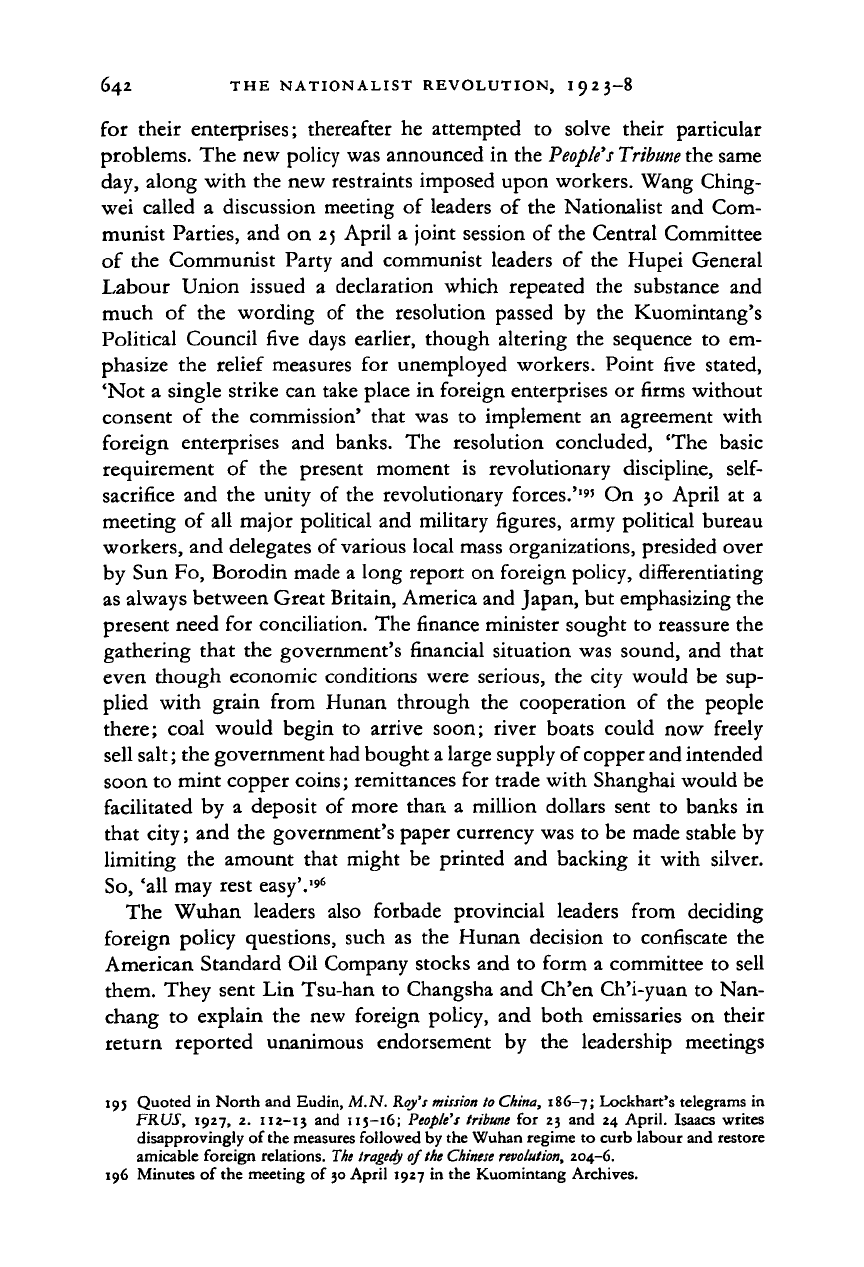
642 THE NATIONALIST REVOLUTION, I 9 2 3-8
for their enterprises; thereafter he attempted to solve their particular
problems. The new policy was announced in the
People's Tribune
the same
day, along with the new restraints imposed upon workers. Wang Ching-
wei called a discussion meeting of leaders of the Nationalist and Com-
munist Parties, and on 25 April a joint session of the Central Committee
of the Communist Party and communist leaders of the Hupei General
Labour Union issued a declaration which repeated the substance and
much of the wording of the resolution passed by the Kuomintang's
Political Council five days earlier, though altering the sequence to em-
phasize the relief measures for unemployed workers. Point five stated,
'Not a single strike can take place in foreign enterprises or firms without
consent of the commission' that was to implement an agreement with
foreign enterprises and banks. The resolution concluded, 'The basic
requirement of the present moment is revolutionary discipline,
self-
sacrifice and the unity of the revolutionary forces.'
1
" On 30 April at a
meeting of all major political and military figures, army political bureau
workers, and delegates of various local mass organizations, presided over
by Sun Fo, Borodin made a long report on foreign policy, differentiating
as always between Great Britain, America and Japan, but emphasizing the
present need for conciliation. The finance minister sought to reassure the
gathering that the government's financial situation was sound, and that
even though economic conditions were serious, the city would be sup-
plied with grain from Hunan through the cooperation of the people
there; coal would begin to arrive soon; river boats could now freely
sell salt; the government had bought a large supply of copper and intended
soon to mint copper coins; remittances for trade with Shanghai would be
facilitated by a deposit of more than a million dollars sent to banks in
that city; and the government's paper currency was to be made stable by
limiting the amount that might be printed and backing it with silver.
So,
'all may rest easy'.
196
The Wuhan leaders also forbade provincial leaders from deciding
foreign policy questions, such as the Hunan decision to confiscate the
American Standard Oil Company stocks and to form a committee to sell
them. They sent Lin Tsu-han to Changsha and Ch'en Ch'i-yuan to Nan-
chang to explain the new foreign policy, and both emissaries on their
return reported unanimous endorsement by the leadership meetings
195 Quoted in North and Eudin, M.N. Roy's
mission
to
China,
186-7; Lockhart's telegrams in
FRUS, 1927, 2. 112-1} and 115-16; People's
tribune
for 2} and 24 April. Isaacs writes
disapprovingly of the measures followed by the Wuhan regime to curb labour and restore
amicable foreign relations.
The tragedy
of
the Chinese
revolution,
204-6.
196 Minutes of the meeting of 30 April 1927 in the Kuomintang Archives.
Cambridge Histories Online © Cambridge University Press, 2008
